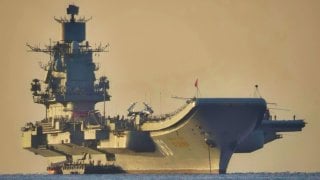The Pathetic History of Russia’s Admiral Kuznetsov Aircraft Carrier
The Admiral Kuznetsov is a symbol of the kind of ambitions that has long enraptured the minds of both Soviet and Russian naval war planners. And it is a continual reminder of how Russia has never been able to live up to those ambitions in any significant way.
Russia’s Admiral Kuznetsov aircraft carrier has been the butt of all jokes among the world’s modern navies. Indeed, it is a continuing point of shame among the Russian military—and a continual reminder of the truly shambolic end of the Soviet Union. Despite this, though, Moscow insists on keeping this disastrous ship going.
The question many people have is: why? Why are the Russians so committed to keeping this floating reminder of the misery and failures of the last thirty years going?
It all goes back to the final decade of the Cold War. The Soviet Union’s navy has always been a dynamo when it came to submarine warfare. Beyond that, though, the Soviet Navy was always a glorified regional force. Lacking aircraft carriers, the Soviet Navy dreamed of going tit-for-tat with the United States Navy and its massive fleet of aircraft carriers. Unable to match the aircraft carrier power of the Americans, the Soviets always stopped shy of committing their limited resources to what was likely going to be a fruitless endeavor.
But by the 1980s, a shift had occurred in the Soviet Navy’s strategic thinking.
Unimpressive origins
First laid in 1982, the carrier’s origins can be found at least a decade earlier. Back then, the Soviet Union was generally riding high. It was the era of Leonid Brezhnev and the world seemed to be the Soviet’s geopolitical oyster whereas the Americans were mired in the deep malaise of the post-Vietnam and post-Watergate era.
Between those scandals, the failed leadership of President Jimmy Carter, and the various socioeconomic crises that afflicted the United States, few in Moscow believed that a decade after it would be their empire that was crumbling to dust.
After eschewing proper aircraft carrier capabilities for years, the Soviets decided to commit to building a real carrier. The goal was to build capacity and challenge the Americans over time in a domain where the Americans believed they had achieved dominance.
Given the geopolitical context of when the Admiral Kuznetsov was first conceived, it’s fair to say that the Soviets believed they could beat the Americans over time. But let this be a lesson to any great power that assumes its current geopolitical reality will be the same geopolitical reality it will experience a decade later.
Almost as soon as the great ship was laid down, compromises had to be made on her design. The Soviets could not meet the design specifications of the original plan for the Admiral Kuznetsov. There were real technological limitations that the Reds encountered when trying to create a carrier that could rival that of the United States Navy. The Soviets wanted the carrier to project Soviet airpower as well as to provide an added layer of protection for the Soviet Red Navy’s ballistic missile nuclear-powered submarines.
Under what were then the conditions of the Soviet-NATO rivalry, the combined navies of the NATO alliance could hunt and kill many Soviet nuclear missile submarines with sophisticated anti-submarine warfare planes. Moscow hoped to negate these capabilities by having carriers nearby that could interdict these NATO sub-killers with carrier-based airpower assets.
Even the carrier’s planes didn’t work!
As an aside, the carrier-based planes that were being developed to operate aboard the Admiral Kuznetsov, such as the Yakolev Design Bureau’s Yak-38, were abject failures. They never lived up to their promise and caused many more problems for the Soviets than they solved. Indeed, the Yak-38 was deemed to have been “totally unreliable in combat” by Soviet engineers and pilots.
So, even if the Admiral Kuznetsov had operated perfectly within its design parameters (which it has never been able to do), its airwing would have been a hindrance to its strategic usefulness.
Skirting international law (a Soviet pastime)
What’s more, the Soviets had to make radical alterations to the proposed carrier because they intended to use this vessel in the Black Sea. Well, according to the Montreux Convention made between Russia and Turkey, the Russians are not allowed to send aircraft carriers through the Turkish Strait.
So, the Reds downsized the original plans for the Admiral Kuznetsov and reclassified it as a “heavy aircraft-carrying cruiser.” Once the compromises started on the design and its classification, the carrier’s potential was shot. When the Soviet Union began collapsing, it became a massive, wasting asset. Yet, the Russian Federation’s government that succeeded the Soviet Union did not want to mothball the disastrous boat. Russia kept putting good money into a bad investment.
A dream too far
And the reason is simple. It was the same reason that promoted the Soviet Navy to build the failed ship in the first place. That was because the Russians dream of becoming a truly world-spanning naval power. Russia continues to possess a dominant submarine force, and the Russian Navy is a perennial threat to Russia’s near-abroad.
But, beyond that, the Russians struggle to project comprehensive naval power across the globe the way that the Americans and their allies do. By keeping even a dilapidated carrier operational, the theory goes that the Russian Navy can practice proper carrier operations.
The Chinese do it better, too
Indeed, this was the logic behind the Chinese acquiring the old Soviet carrier Varyag (the original sister ship to the Admiral Kuznetsov). Unlike the Russian Navy, however, the Chinese People’s Liberation Army Navy (PLAN) was actually able to make the old Soviet carrier it purchased into a real training ship for modernizing its navy and creating a viable carrier force. The Admiral Kuznetsov is so old and poorly built (and maintained), that the Russians cannot even reliably use it as a training ship.
The Admiral Kuznetsov is a symbol of the kind of ambitions that has long enraptured the minds of both Soviet and Russian naval war planners. And it is a continual reminder of how Russia has never been able to live up to those ambitions in any significant way.
One would think they would have gotten the message in Moscow by now and simply focus on dominating their near-abroad with their wonderful submarine capability as opposed to trying to build aircraft carriers that will never rival American carriers (and may very well be obsolete anyway, due to the advent of anti-access/area-denial, A2/AD, systems).
About the Author
Brandon J. Weichert, a National Interest national security analyst, is a former Congressional staffer and geopolitical analyst who is a contributor at The Washington Times, the Asia Times, and The-Pipeline. He is the author of Winning Space: How America Remains a Superpower, Biohacked: China’s Race to Control Life, and The Shadow War: Iran’s Quest for Supremacy. His next book, A Disaster of Our Own Making: How the West Lost Ukraine, is available for purchase wherever books are sold. Weichert can be followed via Twitter @WeTheBrandon.


